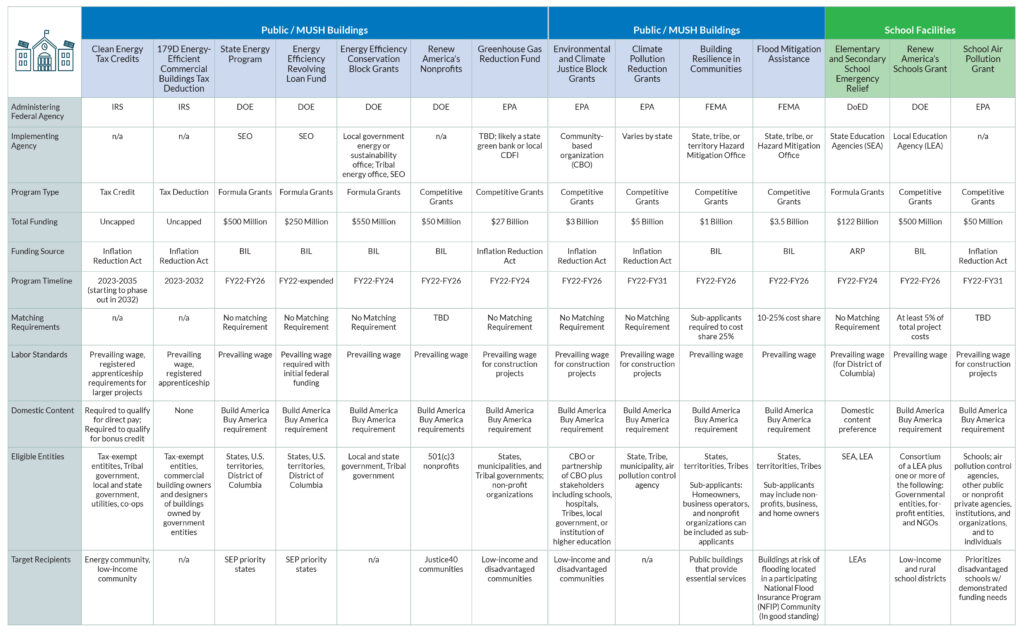Five Reasons to Invest Federal Funding into Retrofits for Schools, Hospitals and other Public Buildings
The passage of the Bipartisan Infrastructure Law (BIL)—previously known as the Infrastructure Investment and Jobs Act (IIJA)—and the Inflation Reduction Act means more federal funding is available to upgrade and retrofit our public-serving institutions. In particular, Municipal, University, School, and Hospital (MUSH) buildings that serve as essential community assets represent a significant opportunity to reduce greenhouse gas emissions, improve health outcomes, build climate resilience, and support and create good, local jobs all while addressing equity and environmental justice.
- Climate: The building sector—including residential and commercial—is one of the largest emitting sectors in the United States, representing 30% of total greenhouse gas emissions. Within the commercial U.S. building sector, there are close to one million MUSH buildings, which tend to be more energy- and water intensive buildings because they are older, larger, and/or have high electricity demand. One study found that upgrading all existing MUSH buildings could reduce annual carbon dioxide (CO2) emissions by more than 52 million metric tons.
- Health: Given that people in the United States spend 90% of their time indoors, there are also health considerations with older MUSH buildings. Retrofitting MUSH buildings represents an opportunity to improve and protect human health through improving indoor air quality, remediating legacy toxics, and utilizing healthy building materials that limit hazardous chemical exposures.
- Resilience: MUSH buildings are often public-serving institutions that may serve multiple purposes, including as community centers and resilience hubs. Public schools, for example, often also serve as polling places and emergency shelters. Public or non-profit hospitals, similarly, serve the public good and also must remain operable during extreme weather.
- Good Jobs: There is a high density of union members working in MUSH buildings—including school and hospital staff and public service employees. Additionally, when building projects meet strong labor standards, they support quality jobs in construction and ensure the work is done right the first time and projected benefits are realized. Building retrofits create job opportunities in manufacturing, construction, and professional trades. Jobs in the energy efficiency sector number over 2.1 million, representing one of the largest technology groups in the energy sector.
- Equity: Early in his administration, President Biden launched the Justice40 Initiative to ensure that a minimum of 40% of all benefits of climate and clean energy federal investments go to disadvantaged communities, including those that are marginalized, underserved, and overburdened by pollution. This includes building retrofit projects as well as relevant workforce development programs. In the case of MUSH buildings, benefits can manifest as both local jobs created as well as public buildings upgraded in disadvantaged communities.
Federal Funding Opportunities for MUSH Building Upgrades
There are myriad funding opportunities across federal agencies that are available for retrofitting MUSH buildings. This includes clean energy and energy efficiency tax incentives through the Internal Revenue Service. In particular, clean energy tax credits are now accessible to tax-exempt institutions like schools, non-profit hospitals, and local governments thanks to “direct pay.” MUSH buildings can also take advantage of new funding from the U.S. Department of Energy, which oversees energy efficiency grant and loan programs; the U.S. Environmental Protection Agency, which oversees climate and environmental programs; and the U.S. Federal Emergency Management Administration, which administers climate resilience funding.
Check out our detailed MUSH buildings roadmap, to learn more about these federal funding opportunities.
